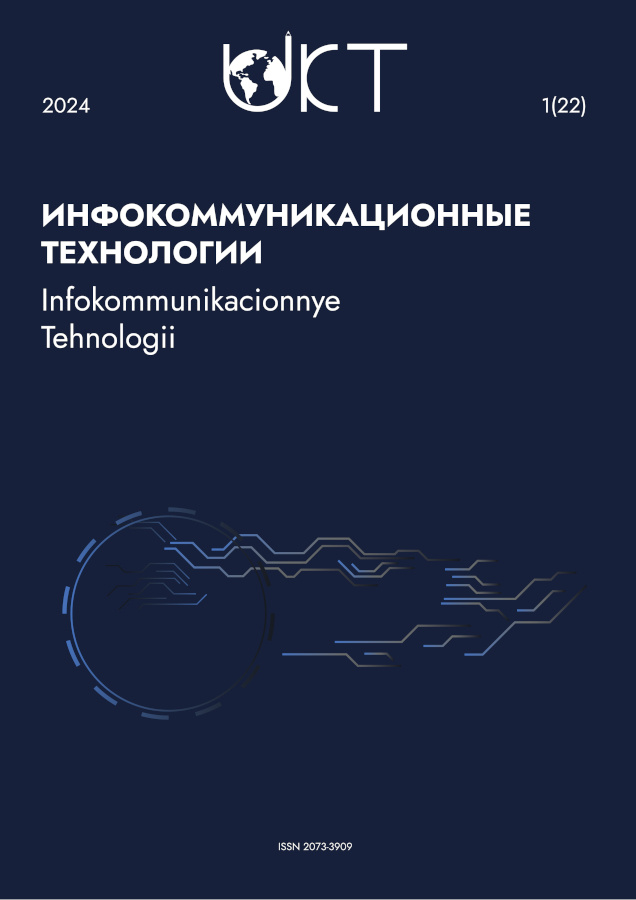Mathematical modeling of secure multipoint video conference sessions using multilayer graphs
- 作者: Gladkikh А.А.1, Mishin D.V.2, Driagin S.А.3, Korsunskii A.S.3
-
隶属关系:
- Ulyanovsk State Technical University
- Povolzhskiy State University of Telecommunications and Informatics
- Research-and-Production Association «Mars»
- 期: 卷 22, 编号 1 (2024)
- 页面: 31-42
- 栏目: Telecommunication Systems and Devices
- URL: https://journals.eco-vector.com/2073-3909/article/view/689818
- DOI: https://doi.org/10.18469/ikt.2024.22.1.04
- ID: 689818
如何引用文章
全文:
详细
The article describes a multilayer graph model for multipoint videoconference sessions. The model presented in this study allows to specify requirements for quality of video capture quality when transferred between terminals and multipoint control unit at the service layer, as well as assessing bandwidth performance and delay of datalink channels at the secure and transport network layer. The given multilayer graph model for videoconference system is designed taking into account the features of secure network configuration, in which several overlay network layers are distinguished over transportation networks. This model specifies a structure of multipoint videoconference session at service layer, at which videoconferencing terminals interoperate through server. Traffic flows generated during session are distributed according to routing rules at the secure network layer. A purpose to select the most optimal route configuration for the entire session includes a number of alternative methods to distribute traffic for each pair of client-server communication seems to be rather complicated. The study proposes an algorithm for searching the shortest path in the graph of a secure overlay network with a step-by-step projection fer each individual route section onto the underlying level of the transport network to find the shortest path within its boundaries. An example for solving a problem on finding route in regard to the overlay network requirements and the actual traffic flow through the transportation network is given. Minimization of the capacity usage of leased channels was chosen as the optimality criterion. Experiments were conducted to evaluate the session quality based on the objective methods for various video-stream parameters, and corresponding quantitative estimates of the required bandwidth in order to organize a session.
作者简介
А. Gladkikh
Ulyanovsk State Technical University
编辑信件的主要联系方式.
Email: a_gladkikh@mail.ru
Professor of Radio Engineering, Telecommunications and Information Security Department, Doctor of Technical Sciences
俄罗斯联邦, UlyanovskD. Mishin
Povolzhskiy State University of Telecommunications and Informatics
Email: d.mishin@psuti.ru
Professor of Radio Electronic Systems Department, Doctor of Technical Sciences
俄罗斯联邦, SamaraS. Driagin
Research-and-Production Association «Mars»
Email: s_drg@mail.ru
Deputy Chief Designer
俄罗斯联邦, UlyanovskA. Korsunskii
Research-and-Production Association «Mars»
Email: aksspb@mail.ru
Deputy Chief Designer, PhD in Technical Sciences
俄罗斯联邦, Ulyanovsk参考
- Recommendations ITU-T E.800 (09/2008). Definition of Terms Related to Quality of Service. Geneva: MSE, 2009, 32 p. (In Russ.)
- Ma J., Li M., Li H.-J. Traffic dynamics on multilayer networks with different speeds. IEEE Transactions on Circuits and Systems II: Express Briefs, 2022, vol. 69, no. 3, pp. 1697–1701. doi: 10.1109/TCSII.2021.3102577
- Rodrigues H. et al. Traffic optimization in multi-layered WANs using SDN. IEEE 22nd Annual Symposium on High-Performance Interconnect. Mountain View, 2014, pp. 71–78. doi: 10.1109/HOTI.2014.23
- Interdonato R. et al. Multilayer network simplification: approaches, models and methods. Computer Science Review, 2020, no. 36. URL: https://www.sci-hub.ru/10.1016/j.cosrev.2020.100246 (accessed: 10.06.2024).
- Ageev D.V. Designing the modern telecommunication systems using multilayer graphs. Vostochnoevropejskij zhurnal peredovyh tekhnologij, 2010, vol. 4, no. 2 (46), pp. 75–77. (In Russ.)
- Ageev D.V. Structural synthesis of WDM network with optical converters using a model represented as a multilayer graph. Problemi telekomunikacij, 2012, no. 2 (7), pp. 3–17. (In Russ.)
- Min X. et al. Study of subjective and objective quality assessment of audio-visual signals. IEEE Transactions on Image Processing, 2020, vol. 29, pp. 6054–6068. doi: 10.1109/TIP.2020.2988148
- Cheng S. et al. Screen content video quality assessment: subjective and objective study. IEEE Transactions on Image Processing, 2020, vol. 29, pp. 8636–8651. doi: 10.1109/TIP.2020.3018256
- Recommendations ITU-R BT.500-14. (10/2019). Methodologies for the Subjective Assessment of the Quality of Television Images. Geneva: MSE, 2020, 104 p. (In Russ.)
- Madhusudana P.C. et al. Subjective and objective quality assessment of high frame rate videos. IEEE Access, 2021, vol. 9, pp. 108069–108082.
- Bakurov I. et al. Structural similarity index (SSIM) revisited: a data-driven approach. Expert Systems with Applications, 2022, vol. 189. URL: https://www.researchgate.net/publication/355499235_Structural_Similarity_Index_SSIM_Revisited_a_Data-Driven_Approach (accessed: 10.06.2024).
- Zhang L. et al. Overview of full-reference video quality metrics and their performance evaluations for videoconferencing application. Journal of Electronic Imaging, 2019, vol. 28, no. 2, pp. 023001–023007.
- Moldovan A.-N., Ghergulescu I., Muntean C.H. VQAMap: A novel mechanism for mapping objective video quality metrics to subjective MOS scale. IEEE Transactions on Broadcasting, 2016, vol. 62, no. 3, pp. 610–627. doi: 10.1109/TBC.2016.2570002
- Klink J., Uhl T. Video quality assessment: some remarks on selected objective metrics. International Conference on Software, Telecommunications and Computer Networks (SoftCOM). Split, 2020. doi: 10.23919/SoftCOM50211.2020.9238303. URL: https://www.researchgate.net/publication/345806819_Video_Quality_Assessment_Some_Remarks_on_Selected_Objective_Metrics (accessed: 15.06.2024).
- Akramullah S. Digital Video Concepts, Method and Metrics. Quality, Compression, Performance and Power-off Analysis. New York City: Apress, 2014, 368 p.
- Shahid M., Abebe M.A., Hardeberg J.Y. Assessing the quality of videoconferencing: from quality of service to quality of communication. Electronic Imaging, 2018, pp. 235-1–235-7. doi: 10.2352/ISSN.2470-1173.2018.12.IQSP-235
补充文件







